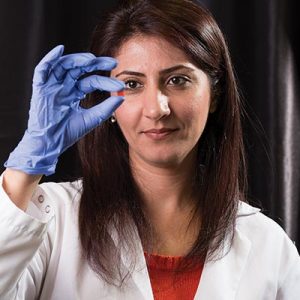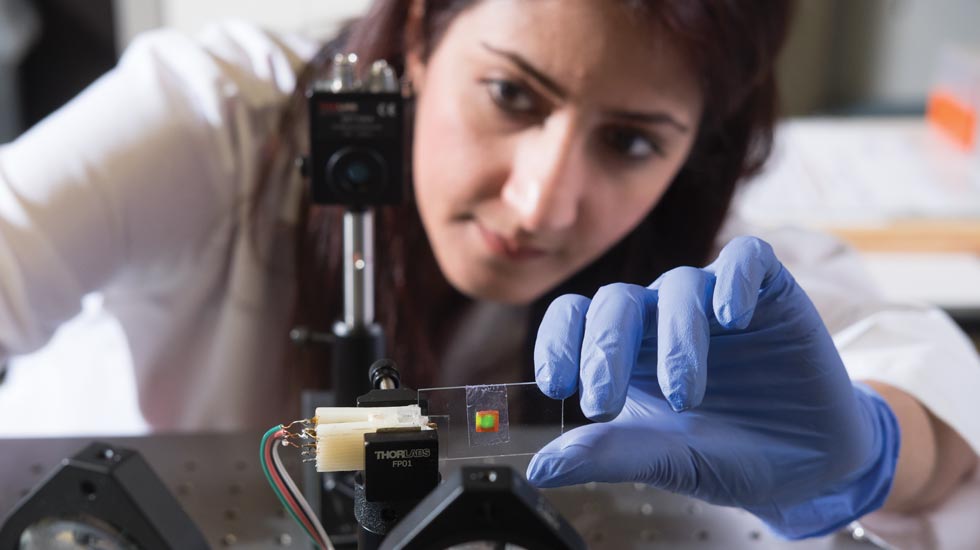Crystal Clear
By Whitney Heins. Photography by Shawn Poynter.
Ask Mahshid Ahmadi who she credits for getting her interested in science and she’ll tell you it was Professor Balthazar.
Was this a professor she had in undergrad? No, he’s a cartoon character that she used to watch as a young girl growing up in Iran. The zany inventor made chemistry look fun. Now, as an assistant research professor in materials science and engineering (MSE), Ahmadi still thinks chemistry is fun—especially when placed at the intersection of materials science, physics, and electronics.
“This position gives me the opportunity to see science problems from different perspectives,” she shared. “It lets me think outside of the box which is the key to finding innovative solutions.”

Ahmadi and her colleagues MSE Professor Bin Hu and Assistant Professor of Nuclear Engineering Eric Lukosi, are innovating as part of one of the first few groups in the world to investigate a novel class of materials for multifunctional detectors, such as the dual gamma ray-neutron detectors used to detect high-energy radiations.
The non-conventional group of materials Ahmadi is working with is called hybrid organic-inorganic perovskite materials. Organic materials are cheap, easy to make, and flexible. Inorganic materials like silicon can have strong optical and electronic properties making them the go-to for solar cell and sensor devices. Put them together and you have the dream team—the ability to design efficient devices that are relatively easy and inexpensive to make.
“I’m very passionate about transforming technologies through the development of new high-performance and non-conventional materials with the potential to change the way we architect opto- and electronic devices,” Ahmadi shared.
Translated to the everyday world, it means more energy-efficient and low-cost rooftop solar panels, cheaper medical imaging equipment for disease diagnosis, and security systems that can more easily detect threats, to name a few advances.
These powerful properties are housed in a beautiful, almost Tennessee-orange-colored crystal. Discovered several decades ago, scientists had all but given up on harnessing the strong capabilities of the hybrid perovskite due to its complicated properties.
Researchers typically must mix the materials together, melt them at high temperatures using large, expensive equipment, and then wait several weeks for the crystals to grow. Inside the lab at JIAM, and with financial support from the US government, Ahmadi is not daunted by the complexity of the task. She is working on a more cost-effective technique to grow single crystals in just one day that contain properties finely tuned to the desired application.
“The organic component renders good chemical solubility and facilitates solution growth,” Ahmadi explained.
The final product is an extended network of crystalline building blocks with good electronic properties. The material can grow as a very thin film—just a few nanometers in size—for use in tiny solar cells like in a watch or calculator. Or, it can be grown in a larger three-dimensional crystal, about a millimeter in size, for use in sensors and detectors.
Ahmadi finds this basic research exciting on every level and feels especially grateful to be able to conduct her work at a world-class facility with the strong support of her departmental colleagues, staff, and head—all at a place that seems to be getting better every day.
“When I walk through UT’s campus, I always see new construction, new research facilities, and this shows how people are working hard to make UT the best place for education and learning,” she shared. “I am glad to be part of this development.”
Ahmadi does her part in education by involving students in her research. She hopes to inspire them as her colleagues—and Professor Balthazar—have inspired her.
“Science is both an art and a profession. And, being a scientist is very rewarding. You are solving important problems and the work is very, very valuable,” she said.
Indeed, being a scientist has the power to change lives, including your own.
Read about crystal growth at UT and the Scintillation Materials Research Center.
